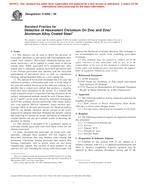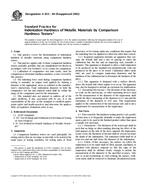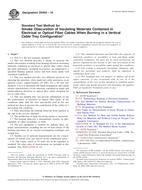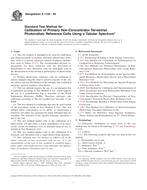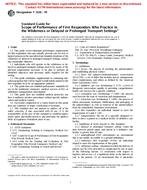ASTM D6492-99
- Standard Practice for Detection of Hexavalent Chromium On Zinc and Zinc/Aluminum Alloy Coated Steel
- standard by ASTM International, 12/10/1999
- Publisher: ASTM
$23.00$46.80
1.1 This practice can be used to detect the presence of hexavalent chromium on galvanized and zinc/aluminum alloy coated steel surfaces. Hexavalent chromium-bearing treatments (passivates) can be applied to coated steels to prevent storage stain. While passivated 55% aluminum-zinc alloy coated steel is commonly painted, passivated galvanized steel is not. Chrome passivation may interfere with the successful pretreatment of galvanized steel, as well as contaminate cleaning and pretreatment baths on a coil coating line.
1.2 The amount of hexavalent chromium that will cause the indicator to produce a discernible pink color is in the range of 0.5 parts per million dissolved in the indicator solution. It is possible that a coated steel surface that produces a negative result does have chromium on the surface. If a material that yields a negative result is suspected of having chromium on the surface, instrumental methods should be used. Chrome deposits of 1 mg/ft² can be easily missed by analytical instruments such as the scanning electron microscope with energy dispersive x-ray analysis (EDXA) capability. Auger electron spectroscopy (AES) or electron spectroscopy for chemical analysis (ESCA) can identify chemical species present in the levels required for adeqate detection. Stripping the metallic coating and analyzing for chrome by atomic absorption or inductively coupled plasma can also give reliable results in detecting the presence of chrome.
1.3 This practice is designed to be a qualitative means of screening chrome passivated coils from those which are not chrome passivated.
1.4 Some chromium-free passivates are being used commercially. Although these products will test negative for hexavalent chromium, they may interfere with cleaning and pretreating. Chromium bearing passivates that contain film forming constituents such as acrylic resins are also being commercially applied. The reaction of these products to the spot test will vary. Abrading the surface with emery paper will improve the likelihood of reliable detection. This technique is not recommended for acrylic resin containing passivation treatments.
1.5 This standard does not purport to address all of the safety concerns, if any, associated with its use. It is the responsibility of the user of this standard to establish appropriate safety and health practices and determine the applicability of regulatory limitations prior to use.
Related Products
ASTM A833-84(2001)
Standard Practice for Indentation Hardness of Metallic Materials by Comparison Hardness Testers..
$23.00 $46.80
ASTM D5424-10
Standard Test Method for Smoke Obscuration of Insulating Materials Contained in Electrical or Optica..
$30.00 $60.00
ASTM E1125-05
Standard Test Method for Calibration of Primary Non-Concentrator Terrestrial Photovoltaic Reference ..
$26.00 $52.80
ASTM F1616-95
Standard Guide for Scope of Performance of First Responders Who Practice in the Wilderness or Delaye..
$23.00 $46.80

